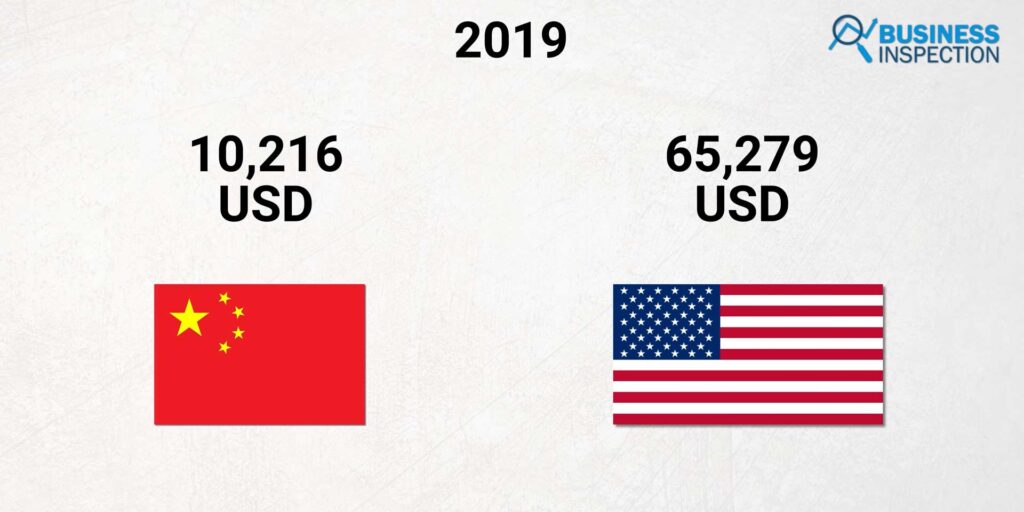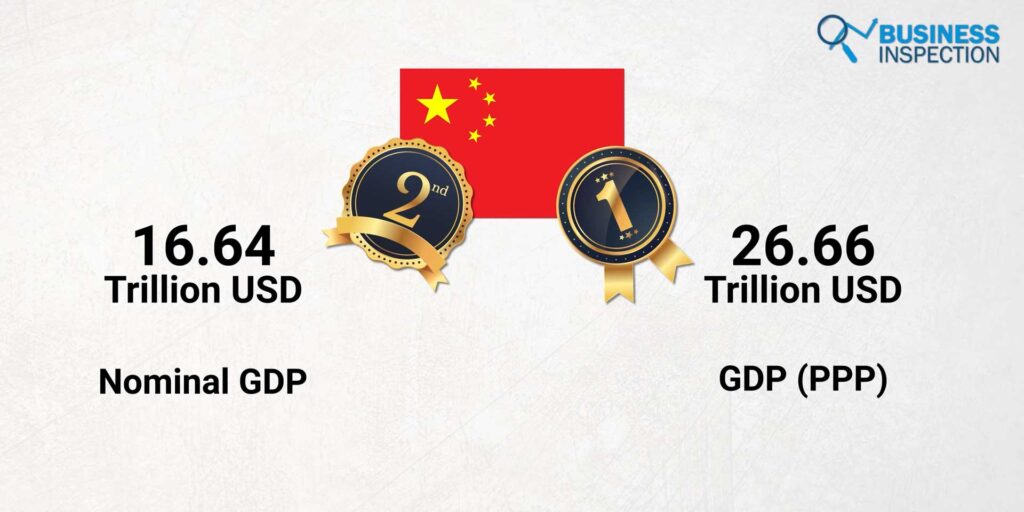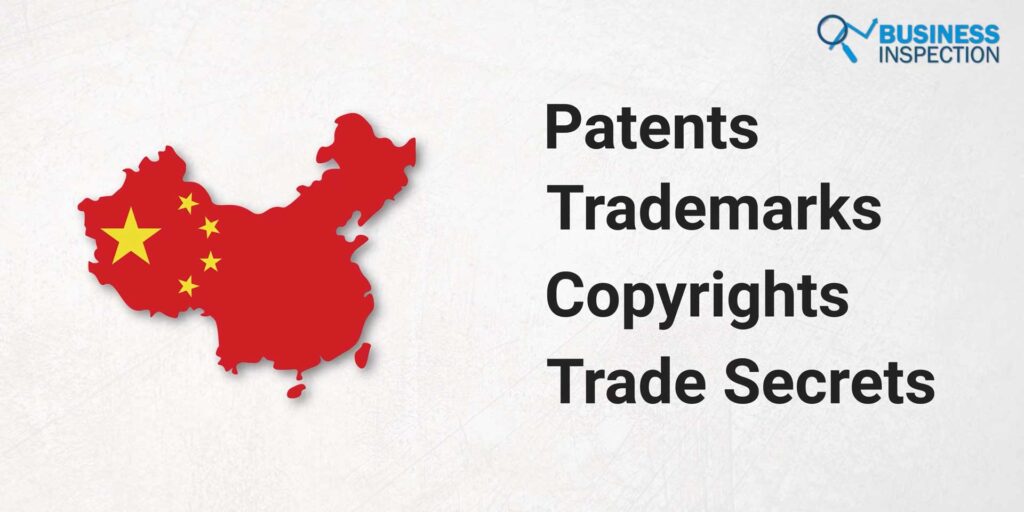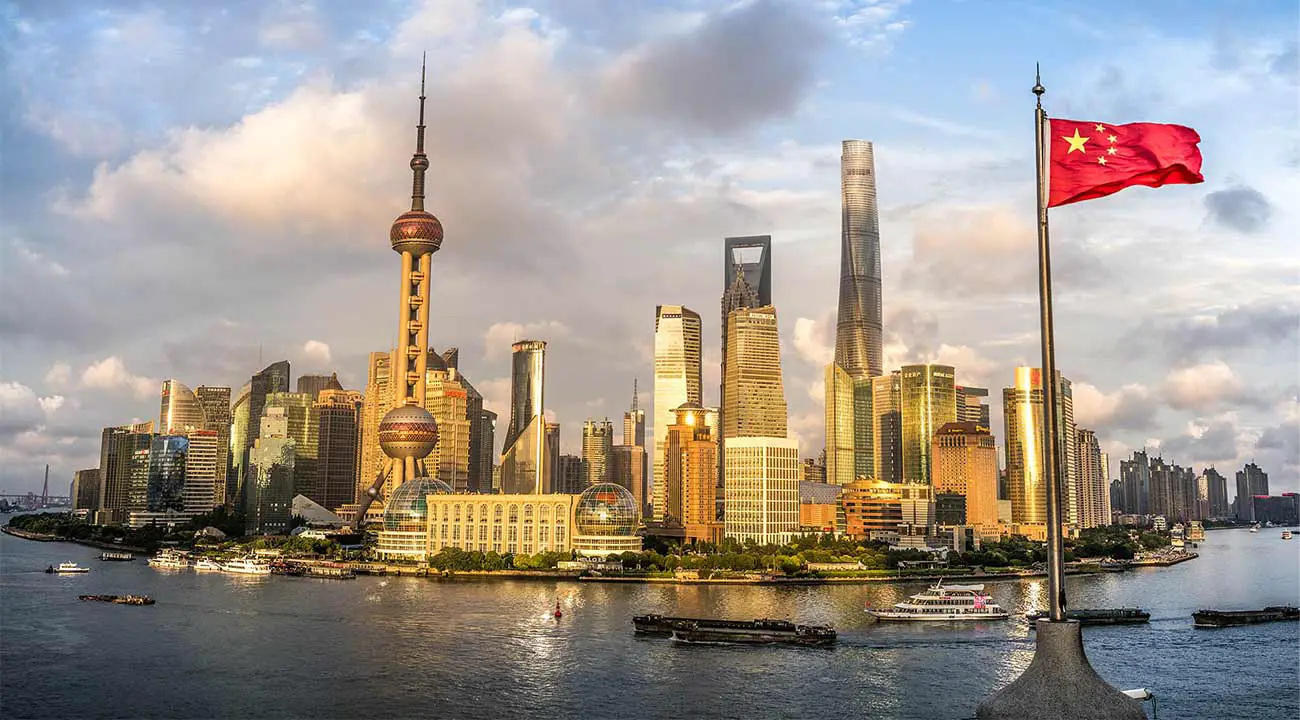Table of Contents
Just over 40 years ago, in 1978, China was not even in the top eight economies of the world. But now, China is the largest economy in terms of purchasing power parity (PPP) and the second largest in terms of nominal GDP. The US and China are in a sort of race to become the undisputed largest economy in the world. This race is made even more interesting by the fact these two economies cannot be more ideologically different from each other.
The United States is a capitalist economy, whereas China believes in a socialist economic model – where capital should be owned by everyone, public welfare should trump personal wealth, and the class divide should be minimal.
To easily understand the difference between these two systems, there is an oversimplified but popular analogy going around in social media, which although, not enough to understand the nitty-gritty of the two systems, can be mentioned here just for the sake of simplistic understanding. According to the analogy, capitalism is when you have two cows and you sell one and buy a bull. As a result, the herd multiplies and the owner has more wealth. On the other hand, in socialism, when someone has two cows, he is forced to give one to his neighbor.
This analogy is almost true in the case of the US. But in the case of Chinese socialism, the scenario is almost opposite to our simplified analogy. Four of the ten largest financial centers are located in China. Three of the ten largest stock exchanges are also in China, which is more than any other country can claim.
Continuing on the trend, 698 of the 2755 billionaires of the world are Chinese and the country claims more than 5.3 million millionaires. Only the US has more billionaires and millionaires than China. So it is only natural that from our simplified analogy, someone might be tempted to ask the question – why aren’t the Chinese super-rich not giving their wealth away to their neighbors? And if they are not, then how does ‘Chinese socialism’ actually work?
Current Status of the Economy
The rapid growth of China has been termed an economic miracle. In 1978, the per capita GDP in China was USD 156 and the United States was USD 10,564. That means that an American earned almost 68 times more than an average Chinese person. In 2019, China’s per capita GDP had increased to stand at USD 10,216 and for the US it stood at USD 65,279. So, the difference in income has come down to just above 6 times down from almost 68 times in 1978. In the following 30 years after 1978, the Chinese economy grew at an average rate of 10% per year and since 1990, China has managed to lift 745 million people out of poverty.

Currently, China’s population is 1.44 billion. The nominal GDP of the country is 16.64 trillion dollars and the GDP in PPP terms is 26.66 trillion dollars. This has made China the second-largest economy in nominal terms and the largest in PPP terms. Although its economy has lost a bit of steam since the dawn of the new millennium, it still managed to register a 6.1% growth rate for 2019. This is the highest growth rate for any major economy for that year. But on the other hand, China has a per capita GDP (PPP) of only USD 16,772, which is still far lower than the developed nations of the world.

How Does The Chinese Economy Work?
Despite this phenomenal growth and the fact that it is one of the leading economies of the world, many are still confused about how the economy actually works. By learning about a few factors behind their economic engine and a few of the unique concepts of their economy, one can easily understand how the Chinese economic model really works.
Socialist Market Economy
China calls its economic model a “Socialist Market Economy”. This term was first coined by Jiang Zemin during the 14th National Convention of the Chinese Communist Party in 1992. The party claims that this is the first step in developing socialism. Some experts have opinionated that this is a form of ‘State Capitalism’. In this system, the government enterprises act like private businesses in that they retain all of their profits without remitting them to the exchequer.
The concept is best described through Deng Xiaoping’s own remarks where he claims that economic planning and open markets are not the only defining differences between socialism and capitalism. A planned economy does not necessarily mean a socialist economy. Capitalism has economic planning too and an open market is also possible under socialism. Economic planning and market forces are just two tools to control economic activities.
There is also a provision for private ownership in the Chinese economic model. But China claims that since their economy was very underdeveloped at the time of the communist revolution, therefore some private ownership would increase productivity and help in economic growth. Many within the party believe that this sort of private ownership is compatible with socialism since Karl Marx and Friedrich Engels never advocated for the outright abolishment of private property.
Five Year Plans
All socialist countries are famous for their five-year plans. Currently, China is implementing its 14th five-year plan, which is set for 2021-2025. Since starting these plans in 1953, these plans have continued except for a brief period of the gap.
Through its five-year plans, the Chinese government sets its strategies, work plans, and goals for the next five years. Which way the economy will move forward largely depends on these plans. The economic reforms since the 1980s have also been done through these very five-year plans. Generally, these plans are formulated individually for each region depending on their capacities and economic condition.
Gross domestic product (GDP) at current prices in China (in billion U.S. dollars)
Central Planning vs Regional Planning
Through its economic reforms, China has strayed away from the Soviet Union’s model of central planning. Instead, China formulated a regional planning model, which initiated competition among the economic regions. In this model, the resources of a region are controlled by the local administration instead of the central government. However, the central government still sets policies, guidelines, and economic targets. But how these targets are achieved through utilizing the local resources is up to the local administration.
The central government ranks the local authorities based on how well each region has achieved its given targets. Due to the one-party political system of China, political career progression depends on how well local leaders were able to achieve the targets set for their region. Therefore, local leaders ensure the best utilization of their region’s resources to best achieve the growth targets set for them. This ignites a sort of competition among the regions. The system has been a great success and played a crucial role in China’s development. According to some, this system is the defining characteristic of the Chinese economic model.
The Private Sector
It is difficult to differentiate between the private and public sectors in China. Since the passage of the companies acts in 1993, traditional government businesses have started to change faces. Many government-owned companies have been listed on stock exchanges. This has given birth to the concept of a ‘government-controlled company’ instead of the traditional concept of a ‘government company’. Government-controlled companies are companies where the government owns the majority or controlling shares.
The private sector received a big boost when private companies were legalized in the early years of the century. Private companies now dominate all sectors except for the few sectors where private ownership is still forbidden.
But it would be a mistake to think that a Chinese private business is just like an Australian or an American private business. It might seem like the government does not control private companies. But the Communist Party still has just as much control over private enterprises as at any other time. The government directly or indirectly controls these companies. The most notable example of this is the National Intelligence Act of 2017, which, according to experts, can be used to force telecom companies to assist government intelligence agencies.
Then, in 2020, the communist party published a document titled “Opinion on Strengthening the United Front Work of the Private Economy in the New Era”. Through this document, the party wants to tighten its grip on private companies through its United Front Work Department or UFWD. UFWD is the communist party’s labor organization. The document advises UFWD members to ensure that their employers run their businesses in accordance with the communist party policies or in a manner with “Chinese characteristics”. All of these are part of the Chinese economic model that the party calls “Socialism with Chinese characteristics”.
Special Economic Zone
The Special Economic Zone or SEZ are designated areas where free market policies and favorable government policies like western economies are implemented to attract foreign companies to invest there. Businesses can operate in SEZs without the permission of the central government. Since the first SEZ was set up in 1980, these SEZs have played a vital role in the economic growth of China.
Different SEZs may have different policies. These zones are also used to experiment with new economic policies. If the new policy is successful then they are implemented throughout all zones. When the world talks about China or large Chinese corporations, they are usually talking about the companies located in the SEZs. These are the main fuel behind the Chinese economic engine.
The Other Issues
China clocks many of the top apps and websites in the world. These include Facebook, Instagram, Twitter, Google, etc. China also has many barriers to free trade, such as import or export quotas, etc. This hinders free trade with China. But the same Chinese government takes advantage of global free trade when exporting their own products. This provides them with a one-sided advantage in global trade.
The lack of intellectual property rights is a matter of concern for many countries and businesses. China is infamous for copying the products of big brands and for infringing the copyrights of others. Although recently the country has taken a few commendable steps to address the issue, it has remained a concerning issue for many large corporations around the world. Many believe that this lack of regulation and copyright infringement has played a role in some part behind the growth of many Chinese businesses.

These capitalistic characteristics of the Chinese economy frequently spark debates. China claims that the motive behind these practices is to establish socialism in the long run. On the other hand, some claim that the party’s real motive is to stay in power and gain economic prosperity, and the talk of socialism is only to secure its grip on power.
Only the future will tell which path the Chinese economy will follow. But for now, one thing is for certain despite the confusion surrounding the workings of their economy, China is able to secure its economic growth through its current system of “Socialism with Chinese Characteristics”.










Leave a Comment